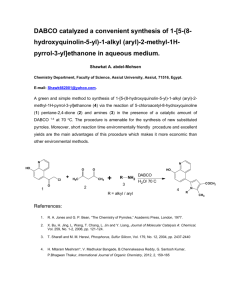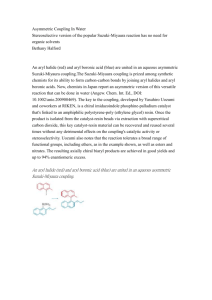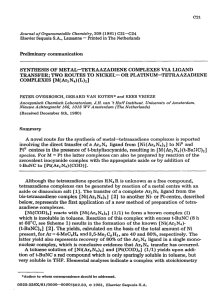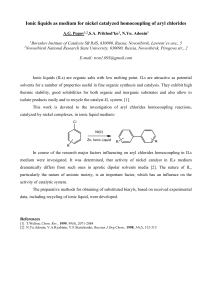Pd-Catalyzed Nucleophilic Fluorination of Aryl Bromides Please share
advertisement
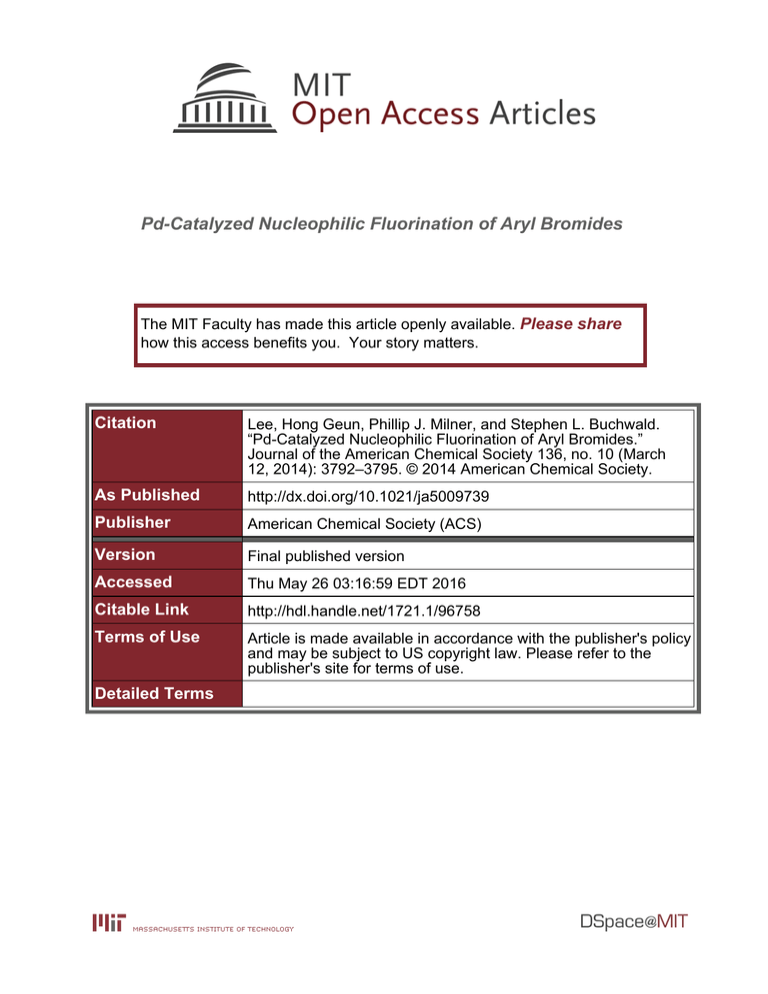
Pd-Catalyzed Nucleophilic Fluorination of Aryl Bromides The MIT Faculty has made this article openly available. Please share how this access benefits you. Your story matters. Citation Lee, Hong Geun, Phillip J. Milner, and Stephen L. Buchwald. “Pd-Catalyzed Nucleophilic Fluorination of Aryl Bromides.” Journal of the American Chemical Society 136, no. 10 (March 12, 2014): 3792–3795. © 2014 American Chemical Society. As Published http://dx.doi.org/10.1021/ja5009739 Publisher American Chemical Society (ACS) Version Final published version Accessed Thu May 26 03:16:59 EDT 2016 Citable Link http://hdl.handle.net/1721.1/96758 Terms of Use Article is made available in accordance with the publisher's policy and may be subject to US copyright law. Please refer to the publisher's site for terms of use. Detailed Terms This is an open access article published under an ACS AuthorChoice License, which permits copying and redistribution of the article or any adaptations for non-commercial purposes. Communication pubs.acs.org/JACS Pd-Catalyzed Nucleophilic Fluorination of Aryl Bromides Hong Geun Lee, Phillip J. Milner, and Stephen L. Buchwald* Department of Chemistry, Massachusetts Institute of Technology, Cambridge, Massachusetts 02139, United States S Supporting Information * ranged from 0.10% to 1.6% with an average of 0.5%. In only one case was the reduction product formed in greater than 1% yield (see the Supporting Information).9 To expand our previously reported strategy (X = OTf, M = Cs; Scheme 1) to the reaction of aryl bromides, we hypothesized that ABSTRACT: On the basis of mechanism-driven reaction design, a Pd-catalyzed nucleophilic fluorination of aryl bromides and iodides has been developed. The method exhibits a broad substrate scope, especially with respect to nitrogen-containing heteroaryl bromides, and proceeds with minimal formation of the corresponding reduction products. A facilitated ligand modification process was shown to be critical to the success of the reaction. Scheme 1. Catalytic Cycle of Pd-Catalyzed Fluorination n recent years, the synthesis of fluorinated arenes has attracted much attention from the community of synthetic organic chemists as a result of the importance of these compounds in pharmaceutical1 and radiological2 applications. Among the various strategies for their preparation,3 nucleophilic fluorination of aryl (pseudo)halides with a metal fluoride salt (MF) is ideal because of the wide availability of substrates and easy access to the fluoride source.4 In 2009, we reported a method for the nucleophilic fluorination of aryl triflates, and to a lesser extent aryl bromides, using Pd catalysts based on bulky biarylphosphine ligands.5 However, only highly activated (i.e., ortho-substituted and electron-deficient) aryl bromides could be successfully fluorinated. More recently, we described an improved system for the fluorination of aryl triflates using AdBrettPhos (1)-based Pd precatalyst 2 (Figure 1).6 I two modifications would be required. First, a more reactive metal fluoride might be necessary to facilitate transmetalation, since the Pd(II) center of an aryl bromide oxidative addition complex is less readily substituted than that of a cationic triflate complex. We postulated that AgF, containing the bromophilic Ag(I) countercation, might drive the transmetalation by irreversible formation of AgBr. Second, a substoichiometric amount of base might be required to facilitate ligand activation. In our recent report, we showed that base induces an in situ ligand modification during the catalytic fluorination of aryl triflates (Scheme 2, A to B to C, X Scheme 2. Ligand Modification during the Catalytic Fluorination Figure 1. Structure of ligands 1 and 3 and precatalyst 2. Since our initial report, however, only a single method that converts unactivated aryl halides to the corresponding aryl fluorides (a Cu-mediated fluorination of aryl iodides) has been described.7 However, this reaction, like many other transitionmetal-mediated fluorination methods, is hampered by the formation of reduction products that are usually difficult to separate from the desired aryl fluoride. Herein we report a practical method for the Pd-catalyzed nucleophilic fluorination of (hetero)aryl bromides that are not activated toward direct nucleophilic substitutions or transition-metal-mediated reactions.3b Our system is applicable to the fluorination of widely available aryl bromides,8 and the process does not result in significant reduction of the aryl halide. Reduction products were not observed for a majority of the examples. In those cases for which reduction products were formed, the amount of Ar−H © 2014 American Chemical Society = OTf) and that the catalyst is effective only when it is supported by the modified ligand.10 In addition, this event was shown to be more pronounced in the case of aryl halide oxidative addition complexes (Scheme 2, A to B, X = Cl or Br),11 suggesting that the process is important in the catalytic fluorination of aryl bromides. We reasoned that AgF might not be basic enough to induce the elimination of HX (Scheme 2, B to C), rendering the ligand Received: January 28, 2014 Published: February 21, 2014 3792 dx.doi.org/10.1021/ja5009739 | J. Am. Chem. Soc. 2014, 136, 3792−3795 Journal of the American Chemical Society Communication modification inefficient. Therefore, it was initially hypothesized that the introduction of a substoichiometric amount of base would promote the formation of C [3·Pd(0)]. To test this hypothesis, the fluorination of 3-bromo-N,Ndimethylaniline was attempted using precatalyst 2 as the Pd source (Table 1).12 As expected, a metal fluoride alone was not Table 2. Pd-Catalyzed Fluorination of Aryl Halides Using Precatalyst 2a Table 1. Effect of Base in the Pd-Catalyzed Fluorination of an Aryl Bromide Using Precatalyst 2a entry MF base yield (%)b 1 2 3 4 5 6 7 8 9 KF CsF AgF AgF AgF AgF AgF AgF AgF − − − NaHCO3 K2CO3 K3PO4 NaF KF CsF 0 0 0 0 11 21 0 71 65 a Reaction conditions: 3-bromo-N,N-dimethylaniline (0.10 mmol), MF (0.20 mmol), base (0.050 mmol), 2 (0.0020 mmol), cyclohexane (1 mL), 130 °C, 14 h. bDetermined by 19F NMR analysis. effective in promoting the transformation (entries 1−3). However, when AgF was used in combination with 0.5 equiv13 of K2CO3 (entry 5) or K3PO4 (entry 6), the desired aryl fluoride product was formed in modest yield, while the use of NaHCO3 was ineffective (entry 4). Ultimately, fluoride bases (except NaF) were shown to be the most effective for promoting the reaction in high yield (entries 7−9). Even though KF and CsF are equally competent, inexpensive and less hygroscopic KF was chosen as the base for reasons of cost and practicality. The optimized reaction conditions were applied to the fluorination of a variety of aryl bromides and iodides (Table 2).14 Substrates with ortho (4 and 5), meta (6−13), and para (14−19) substituents were fluorinated with comparable efficiencies regardless of the electronic nature of the substituents. Importantly, base-sensitive functional groups such as methyl sulfone (6), fluorene (10), and ketone (14 and 15) groups were tolerated, as were nitrile (7), ester (8), and amide (16) groups, which are common in pharmaceutical compounds. In addition, substrates that are not amenable to electrophilic fluorination becauses of potential oxidation, such as alkyl sulfides (9) and electron-rich amines (12 and 13), were also fluorinated in good yields.15 Unactivated aryl iodides were also viable substrates for this reaction (10, 14, and 17). Analogous to our fluorination of aryl triflates, 4-bromoanisole, which is electron-rich and lacks ortho substituents, provided a mixture of regioisomers (19).5,6 We next tried to extend this methodology to the fluorination of heteroaryl bromides using 3-bromo-5-cyanopyridine as a representative substrate. Even though the addition of KF significantly improved the reaction, the conditions failed to provide the fluorinated heteroarene in a satisfactory yield (Table 3, entries 1 and 2). To remedy this situation, we decided to use a precatalyst with a new ligand that had been modified ex situ. We postulated that with heteroaryl substrates, either the ligand modification process is not facile or the resulting modified ligand (analogous to 3) is not effective for the fluorination reaction. a Isolated yields (averages of two runs) are shown. Reaction conditions: aryl halide (1.0 mmol), AgF (2.0 mmol), KF (0.50 mmol), 2 (0.010−0.020 mmol), cyclohexane (10 mL), 14 h. bToluene was used as the solvent. c0.50 mmol scale; yield was determined by 19F NMR analysis. Table 3. Effects of Precatalyst and KF in the Pd-Catalyzed Fluorination of a Heterocyclic Aryl Bromidea entry precatalyst base yield (%)b 1 2 3 4 2 2 22 22 − KF − KF 11 48 21 72 a Reaction conditions: 3-bromo-5-cyanopyridine (0.10 mmol), AgF (0.20 mmol), KF (0.050 mmol), 2 or 22 (0.0020 mmol), 2-MeTHF (1 mL), 130 °C, 14 h. bDetermined by 19F NMR analysis. Therefore, by using a premodified ligand such as 3, we could circumvent the modification process altogether, allowing us to take full advantage of the established system. A synthetic route to ligand 3 is described in Scheme 3.16 The known oxidative addition complex 2011 underwent the desired rearrangement, elimination, and oxidative addition cascade in the presence of 1,8-diazabicyclo[5.4.0]undec-7-ene (DBU) and 1bromo-4-n-butylbenzene.10 The new complex 21 with the modified ligand was treated with excess propane-1,2-diamine to provide free phosphine 3 in 49% overall yield from 20. Ligand 3 was successfully converted to the corresponding cyclooctadiene-ligated Pd(0) precatalyst 22 using our reported conditions.6,17 3793 dx.doi.org/10.1021/ja5009739 | J. Am. Chem. Soc. 2014, 136, 3792−3795 Journal of the American Chemical Society Communication Scheme 3. First Synthesis of Ligand 3 and Precatalyst 22a Table 4. Pd-Catalyzed Fluorination of Heterocyclic Aryl Bromides Using Precatalyst 22a a Reagents and conditions: (a) DBU, 1-bromo-4-n-butylbenzene, THF, 23 °C, 12 h, 81%. (b) Propane-1,2-diamine, THF, 23 °C, 12 h, 61%. (c) [(COD)Pd(CH2TMS)2], pentane, 23 °C, 48 h, 79%. bEllipsoids are shown at 50% probability. Alternatively, a more robust and scalable synthesis was also developed for access to 3 on a gram scale (Scheme 4). The 4-nScheme 4. Scalable Synthesis of Ligand 3a a Isolated yields (averages of two runs) are shown. Reaction conditions: aryl halide (1.0 mmol), AgF (2.0 mmol), KF (0.50 mmol), 22 (0.010−0.030 mmol), 2-MeTHF (10 mL), 14 h. b0.10 mmol scale. cDetermined by 19F NMR analysis. dTBME was used as the solvent. eCyclohexane was used as the solvent. f0.50 mmol scale. were prepared from the corresponding bromides (27−29), although 3-bromopyridine itself furnished a 1:1 para/meta mixture of aryl fluoride regioisomers (not shown). In line with our previous observations, forcing conditions were required to synthesize electron-rich fluoropyridine 29.6 Indole (30), quinoline (31−33), and isoquinoline (34 and 35) derivatives were also prepared in high yields. Heteroaryl bromides with more than one nitrogen atom, such as pyrimidine (36), indazole (37), and quinoxaline (38), were also suitable substrates. Finally, the vascular disorder drug Nicergoline (Sermion)22 was fluorinated to provide analogue 39. This result suggests that our methodology should be viable for the late-stage fluorination of advanced intermediates where pharmaceutically relevant functional groups are present. Notably, five-membered heteroaryl halides remain challenging substrates for this methodology. In conclusion, we have developed a new Pd-catalyzed method for converting unactivated (hetero)aryl bromides and iodides to the corresponding fluorides. The reaction proceeds without significant formation of reduction byproducts, which are difficult to separate from the desired product. The success of the reaction stems from the use of AgF with added KF to promote the reaction and from control of the ligand modification process we previously observed. Future efforts will be focused on identifying the exact role of KF during the reaction and applying this methodology to the synthesis of 18F-containing radiotracers. a Reagents and conditions: (a) 23 (1.0 mol %), K3PO4, THF/H2O, 80 °C, 12 h, 99%. (b) Br2, DMF/CH2Cl2, 0 °C, 30 min, 76%. (c) t-BuLi, THF, −78 °C, 1 h; added to 2-fluoro-1,4-dimethoxybenzene and nBuLi in THF, −78 to 0 °C, 2 h; Br2, 0 °C, 30 min, 65%. (d) t-BuLi, THF, −78 °C, 1 h; CuCl; Ad2PCl, toluene, 140 °C, 48 h, 54%. butylphenyl moiety was installed by Suzuki−Miyaura crosscoupling of commercially available 4-n-butylphenylboronic acid in the presence of XPhos-based precatalyst 23.18 The resulting biaryl 24 was monobrominated to furnish 25, which was converted to the desired product via triaryl 26 using our previously reported protocol.19 The new precatalyst 22 (Table 3, entry 3) showed improved reactivity compared to 2 (entry 1). Unexpectedly, the use of 22 alone with AgF (entry 3) was not as effective as the combined use of 2 with KF and AgF (entry 2). Only when a combination of KF and AgF was used with 22 was the product obtained in high yield (entry 4). This result suggests that KF plays a role beyond simply assisting the modification of 1.20 Employing 22 enabled the successful preparation of fluorinated heteroarenes that are not accessible through traditional SNAr reactions (Table 4). Importantly, the use of 22 rather than 2 for the fluorination of heteroaryl bromides provided superior results in almost all instances (the yields obtained using 2 under identical conditions are shown in parentheses for selected cases).21 In addition, reduction products were not observed (by GC) in the purified samples in any case, with the exception of 30, for which 0.10% Ar−H was observed. 3Fluoropyridine derivatives with varying electronic properties ■ ASSOCIATED CONTENT S Supporting Information * Experimental details and compound characterization data. This material is available free of charge via the Internet at http://pubs. acs.org. ■ AUTHOR INFORMATION Corresponding Author sbuchwal@mit.edu 3794 dx.doi.org/10.1021/ja5009739 | J. Am. Chem. Soc. 2014, 136, 3792−3795 Journal of the American Chemical Society Communication Notes transmetalation with AgF in these cases. Unprotected amino/hydroxyl groups are also not tolerated. (15) Tang, P.; Furuya, T.; Ritter, T. J. Am. Chem. Soc. 2010, 132, 12150. (16) Preliminary unpublished results suggest that 3 containing 4-nbutylphenyl gives the highest yield compared with ligands modified with other aryl groups. (17) Similar to 2, precatalyst 22 is insoluble in most organic solvents. Therefore, spectroscopic characterization was not possible. However, it readily forms the oxidative addition complex 21 and 1,5-COD upon exposure to 1-bromo-4-n-butylbenzene. See the Supporting Information for details. (18) Bruno, N. C.; Tudge, M. T.; Buchwald, S. L. Chem. Sci. 2013, 4, 916. (19) (a) Hoshiya, N.; Buchwald, S. L. Adv. Synth. Catal. 2012, 354, 2031. (b) Fors, B. P.; Dooleweerdt, K.; Zeng, Q.; Buchwald, S. L. Tetrahedron 2009, 65, 6576. (20) Related fluoride effects have been documented. See: (a) Su, W.; Raders, S.; Verkade, J. G.; Liao, X.; Hartwig, J. F. Angew. Chem., Int. Ed. 2006, 45, 5852. (b) Pan, J.; Wang, X.; Zhang, Y.; Buchwald, S. L. Org. Lett. 2011, 13, 4974. (21) It was discovered that 22 is not as effective as 2 for certain nonheterocyclic substrates. This result suggests that 4-n-butylphenyl may not be the best modifying group for the fluorination of non-heterocyclic substrates. The origin of this effect is under investigation in our lab. However, ligand 3 was chosen for study because of its ease of synthesis and generality. (22) Winblad, B.; Fioravanti, M.; Dolezal, T.; Logina, I.; Milanov, I. G.; Popescu, D. C.; Solomon, A. Clin. Drug Invest. 2008, 28, 533. The authors declare the following competing financial interest(s): MIT has obtained or has filed patents on some of the ligands/precatalysts that are described in the paper from which S.L.B. and former/current coworkers receive royalty payments. ■ ACKNOWLEDGMENTS Research reported in this publication was supported by the National Institutes of Health under Award GM46059. This content is solely the responsibility of the authors and does not necessarily reflect the views of the National Institutes of Health. P.J.M. thanks the National Science Foundation for a predoctoral fellowship (2010094243). We also thank Amgen for an educational donation. The X-ray diffractometer was purchased with the help of funding from the National Science Foundation (CHE 0946721). Dr. Peter Müller (MIT) is acknowledged for solving the X-ray structure of 3. We also thank Dr. Aaron Sather and Mr. Nicholas Bruno (MIT) for assistance with the preparation of the manuscript and GC analysis, respectively. ■ REFERENCES (1) For reviews, see: (a) Purser, S.; Moore, P. R.; Swallow, S.; Gouverneur, V. Chem. Soc. Rev. 2008, 37, 320. (b) Kirk, K. L. Org. Process Res. Dev. 2008, 12, 305. (c) Müller, K.; Faeh, C.; Diederich, F. O. Science 2007, 317, 1881. (2) For reviews, see: (a) Tredwell, M.; Gouverneur, V. Angew. Chem., Int. Ed. 2012, 51, 11426. (b) Miller, P. W.; Long, N. J.; Vilar, R.; Gee, A. D. Angew. Chem., Int. Ed. 2008, 47, 8998. For recent examples, see: (c) Lee, E.; Hooker, J. M.; Ritter, T. J. Am. Chem. Soc. 2012, 134, 17456. (d) Lee, E.; Kamlet, A. S.; Powers, D. C.; Neumann, C. N.; Boursalian, G. B.; Furuya, T.; Choi, D. C.; Hooker, J. M.; Ritter, T. Science 2011, 334, 639. (3) For a review, see: (a) Liang, T.; Neumann, C. N.; Ritter, T. Angew. Chem., Int. Ed. 2013, 52, 8214. Also see: (b) Mu, X.; Zhang, H.; Chen, P.; Liu, G. Chem. Sci. 2014, 5, 275. (c) Fier, P. S.; Hartwig, J. F. Science 2013, 342, 956. (d) Ye, Y.; Schimler, S. D.; Hanley, P. S.; Sanford, M. S. J. Am. Chem. Soc. 2013, 135, 16292. (e) Ichiishi, N.; Canty, A. J.; Yates, B. F.; Sanford, M. S. Org. Lett. 2013, 15, 5134. (f) Mazzotti, A. R.; Campbell, M. G.; Tang, P.; Murphy, J. M.; Ritter, T. J. Am. Chem. Soc. 2013, 135, 14012. (g) Truong, T.; Klimovica, K.; Daugulis, O. J. Am. Chem. Soc. 2013, 135, 9342. (h) Ye, Y.; Sanford, M. S. J. Am. Chem. Soc. 2013, 135, 4648. (i) Fier, P. S.; Luo, J.; Hartwig, J. F. J. Am. Chem. Soc. 2013, 135, 2552. (4) (a) Hollingworth, C.; Gouverneur, V. Chem. Commun. 2012, 48, 2929. (b) Grushin, V. V. Acc. Chem. Res. 2010, 43, 160. (5) Watson, D. A.; Su, M.; Teverovskiy, G.; Zhang, Y.; García-Fortanet, J.; Kinzel, T.; Buchwald, S. L. Science 2009, 325, 1661. (6) Lee, H. G.; Milner, P. J.; Buchwald, S. L. Org. Lett. 2013, 15, 5602. (7) Fier, P. S.; Hartwig, J. F. J. Am. Chem. Soc. 2012, 134, 10795. (8) Aryl iodides are also viable substrates for this reaction. However, we focused on aryl bromides since they are more widely available. (9) The starting materials corresponding to 4 and 5 were contaminated with 0.85% and 0.3% Ar−H, respectively. See the Supporting Information for details. (10) Maimone, T. J.; Milner, P. J.; Kinzel, T.; Zhang, Y.; Takase, M. K.; Buchwald, S. L. J. Am. Chem. Soc. 2011, 133, 18106. (11) Milner, P. J.; Maimone, T. J.; Su, M.; Chen, J.; Müller, P.; Buchwald, S. L. J. Am. Chem. Soc. 2012, 134, 19922. (12) Other sources of Pd were also evaluated; we found that precatalyst 2 is the most effective Pd source. See the Supporting Information for details. (13) The optimal loading of KF was found to be 0.5 equiv. See the Supporting Information for details. (14) To date, this reaction is not effective for unactivated aryl chlorides and substrates with bulky ortho substituents, likely because of slower 3795 dx.doi.org/10.1021/ja5009739 | J. Am. Chem. Soc. 2014, 136, 3792−3795
